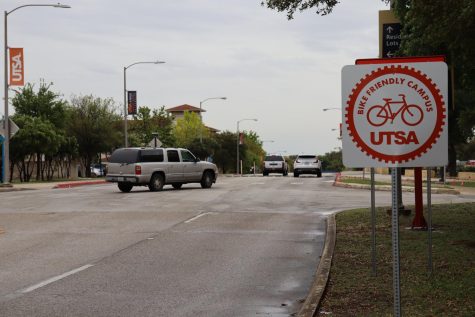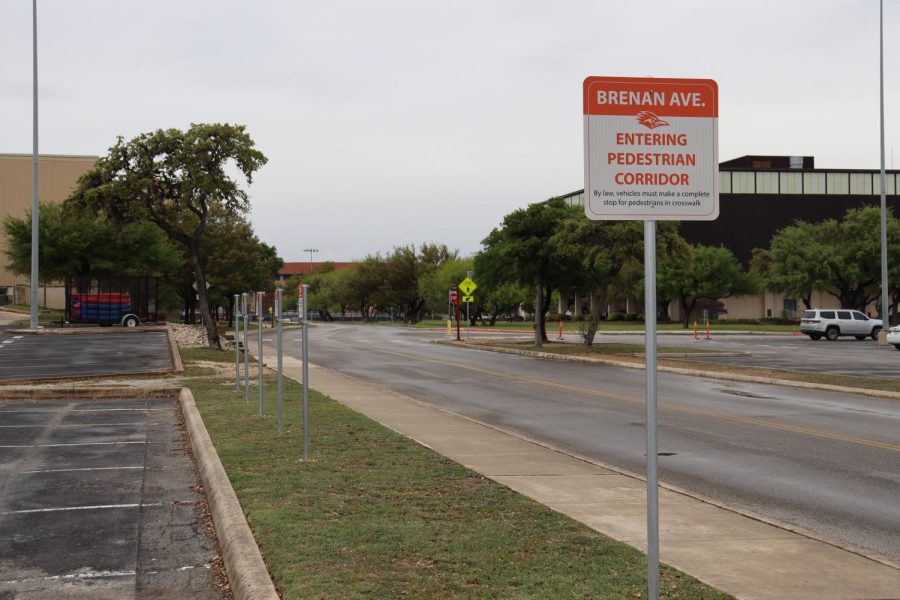Traffic signs along Brenan Avenue signal shared roads
March 21, 2023
Among several ongoing initiatives underway at UTSA, the Office of Sustainability has begun work to encourage alternative transportation efforts on campus. As a result, Brenan Avenue, which connects Brackenridge Avenue to the Loop 1604 access road, will see significant changes in the coming years.
Brenan Avenue used to sit on the Main Campus’ exterior, but now, it more or less divides the campus. While primarily a two-lane road, it grows to four lanes as it bends between Alvarez Hall and Laurel Village. The current proposal, put forth by the Office of Sustainability, would eliminate vehicle traffic on Brenan Avenue and reserve space for pedestrians and alternative transportation methods such as bicycling, skateboards and scooters. In addition, the Office of Sustainability placed signs along Brenan Avenue warning drivers of pedestrians and bicyclists.
Last semester, the Sustainability office hosted several place-making events to garner public opinion on the proposed changes to Brenan Avenue. Assistant Vice President for Campus Planning Josh Gerken described some of the reception.
“The workshops had a great turnout from UTSA students, faculty and staff, and we were able to identify numerous themes from these conversations,” Gerken said. “Some of the most common ones for future placemaking included space types for all kinds of people for socializing and studying, relaxing spaces with comfortable amenities with a wide choice of food and drink, and shady, cool green spaces that are more rural feeling. This feedback is being utilized to help inform future university placemaking opportunities, and Brenan Avenue is included in these areas.”
Gerken further explained what the next step in the Brenan Avenue proposal process would look like.
“Our next step is to present this information to university leadership and share opportunities for promoting safety and walkability on Brenan Avenue,” Gerken said. “Our goal for this year is to utilize the remaining grant funding for the installation of additional features in order to emphasize pedestrian safety.”
Dr. Greg Griffin, an associate professor of urban and regional planning at UTSA, described the need for a democratic approach to decision-making around sustainable projects.
“What I envision [and] hope for is a future that is fundamentally democratic,” Griffin said. “An approach that says people should decide what these best solutions are, and that we need to work together to figure it out.”
Griffin expanded on the different approaches that could be explored regarding transportation.
“For a lot of people, that means different things,” Griffin said. “I am interested in health [and] the environment, so that points us toward small, lightweight vehicles, sometimes electric. That might be bicycling, walking [and] scooters, that sort of thing. But we also have to recognize that does not suit everybody’s needs.”

Last fall, the Office of Sustainability launched its BeakCycle bike share project. A grant from the Texas Department of Transportation aided the program’s launch. Currently, there are 21 BeakCycle racks across the Main Campus. For Griffin, bike share programs in partnership with universities allow for greater accessibility.
“I’m excited about the prospects for bike sharing that the campus sustainability office and others have offered and envisioned as a good solution, particularly for the university,” Griffin said. “Bike sharing solves multiple problems at the same time.”
Griffin also serves as one of the co-principal investigators with ScooterLab. Murtuza Jadliwala, an associate professor in the computer science department, leads the project. Recently, the project was awarded a $1.7 million National Science Foundation grant to assist with the first phase of the project. The scooters will be available on both the main and downtown campuses.
UTSA has made the blueprints for its Campus Master Plan — which the UT System Board of Regents approved in November 2019 — accessible to the public. Part of this process is an overhaul of the entire campus. Opting for a more “pedestrian-oriented and compound campus core,” the Master Plan will transition the bulk of UTSA parking to the exterior of the campus.
“We have to look toward the future of UTSA and how fast we are growing, and suspect we are going to continue to grow,” Griffin said. “Thinking about having our destination closer together, better connected for a variety of different modes [and then] having less conflicts with large fast vehicles. We need to think about pedestrian safety and comfort as a priority.”







